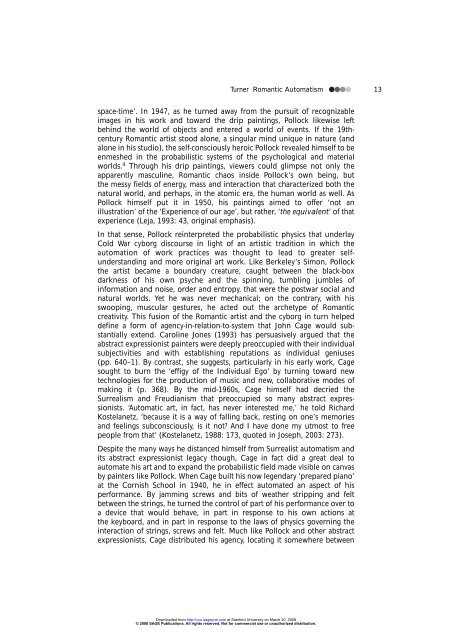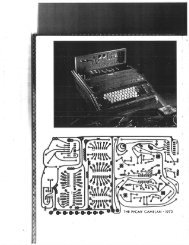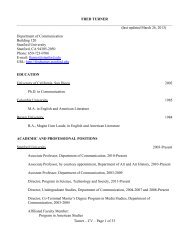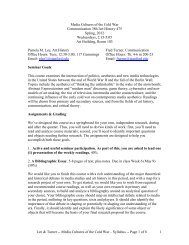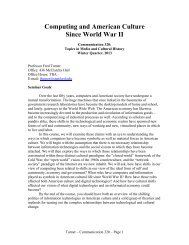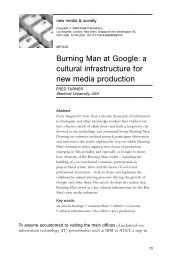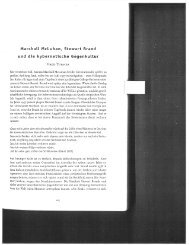Journal of Visual Culture - Fred Turner - Stanford University
Journal of Visual Culture - Fred Turner - Stanford University
Journal of Visual Culture - Fred Turner - Stanford University
Create successful ePaper yourself
Turn your PDF publications into a flip-book with our unique Google optimized e-Paper software.
<strong>Turner</strong> Romantic Automatism 13<br />
space-time’. In 1947, as he turned away from the pursuit <strong>of</strong> recognizable<br />
images in his work and toward the drip paintings, Pollock likewise left<br />
behind the world <strong>of</strong> objects and entered a world <strong>of</strong> events. If the 19thcentury<br />
Romantic artist stood alone, a singular mind unique in nature (and<br />
alone in his studio), the self-consciously heroic Pollock revealed himself to be<br />
enmeshed in the probabilistic systems <strong>of</strong> the psychological and material<br />
worlds. 4 Through his drip paintings, viewers could glimpse not only the<br />
apparently masculine, Romantic chaos inside Pollock’s own being, but<br />
the messy fields <strong>of</strong> energy, mass and interaction that characterized both the<br />
natural world, and perhaps, in the atomic era, the human world as well. As<br />
Pollock himself put it in 1950, his paintings aimed to <strong>of</strong>fer ‘not an<br />
illustration’ <strong>of</strong> the ‘Experience <strong>of</strong> our age’, but rather, ‘the equivalent’ <strong>of</strong> that<br />
experience (Leja, 1993: 43, original emphasis).<br />
In that sense, Pollock reinterpreted the probabilistic physics that underlay<br />
Cold War cyborg discourse in light <strong>of</strong> an artistic tradition in which the<br />
automation <strong>of</strong> work practices was thought to lead to greater selfunderstanding<br />
and more original art work. Like Berkeley’s Simon, Pollock<br />
the artist became a boundary creature, caught between the black-box<br />
darkness <strong>of</strong> his own psyche and the spinning, tumbling jumbles <strong>of</strong><br />
information and noise, order and entropy, that were the postwar social and<br />
natural worlds. Yet he was never mechanical; on the contrary, with his<br />
swooping, muscular gestures, he acted out the archetype <strong>of</strong> Romantic<br />
creativity. This fusion <strong>of</strong> the Romantic artist and the cyborg in turn helped<br />
define a form <strong>of</strong> agency-in-relation-to-system that John Cage would substantially<br />
extend. Caroline Jones (1993) has persuasively argued that the<br />
abstract expressionist painters were deeply preoccupied with their individual<br />
subjectivities and with establishing reputations as individual geniuses<br />
(pp. 640–1). By contrast, she suggests, particularly in his early work, Cage<br />
sought to burn the ‘effigy <strong>of</strong> the Individual Ego’ by turning toward new<br />
technologies for the production <strong>of</strong> music and new, collaborative modes <strong>of</strong><br />
making it (p. 368). By the mid-1960s, Cage himself had decried the<br />
Surrealism and Freudianism that preoccupied so many abstract expressionists.<br />
‘Automatic art, in fact, has never interested me,’ he told Richard<br />
Kostelanetz, ‘because it is a way <strong>of</strong> falling back, resting on one’s memories<br />
and feelings subconsciously, is it not? And I have done my utmost to free<br />
people from that’ (Kostelanetz, 1988: 173, quoted in Joseph, 2003: 273).<br />
Despite the many ways he distanced himself from Surrealist automatism and<br />
its abstract expressionist legacy though, Cage in fact did a great deal to<br />
automate his art and to expand the probabilistic field made visible on canvas<br />
by painters like Pollock. When Cage built his now legendary ‘prepared piano’<br />
at the Cornish School in 1940, he in effect automated an aspect <strong>of</strong> his<br />
performance. By jamming screws and bits <strong>of</strong> weather stripping and felt<br />
between the strings, he turned the control <strong>of</strong> part <strong>of</strong> his performance over to<br />
a device that would behave, in part in response to his own actions at<br />
the keyboard, and in part in response to the laws <strong>of</strong> physics governing the<br />
interaction <strong>of</strong> strings, screws and felt. Much like Pollock and other abstract<br />
expressionists, Cage distributed his agency, locating it somewhere between<br />
Downloaded from<br />
http://vcu.sagepub.com at <strong>Stanford</strong> <strong>University</strong> on March 20, 2008<br />
© 2008 SAGE Publications. All rights reserved. Not for commercial use or unauthorized distribution.


